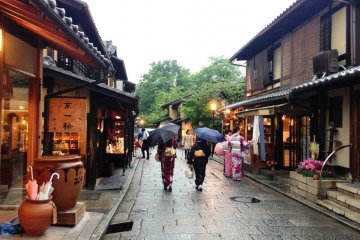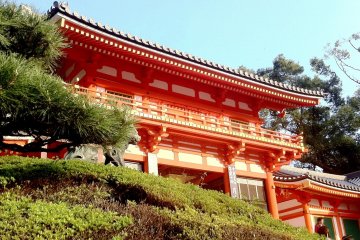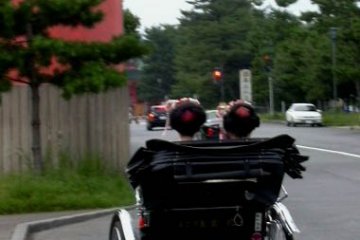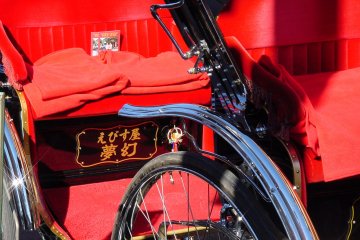We visit Kyoto once or twice a year to visit my mother-in-law who lives about 20 minutes train ride from Kyoto Station. Last week was New Year's vacation we ventured into town to go to the zoo, one of the few places open during the first week of January. Our bus got stuck in New Year’s traffic on the road leading to Heien Shrine, the same neighborhood as Kyoto Municipal Zoo. We decided to get off the crowded over-heated bus before our stop. We found a bench in a small playground by the Municipal LIbrary to sit and eat our packed lunch. It was 2:30, a bit too late to enjoy the zoo at a leisurely pace as sun down in the winter is around 4:30. After checking out the huge crowd waiting to pay their respects in front of Heien Shrine, we were about to head home when a rickshaw caught our son’s attention. Shall we?
We found a signboard with a couple of rickshaws parked in front of the National Museum of Modern Art, across the street from the entrance to the Heien Shrine. The cheapest option for our family was ten minutes for Y3,000. One person would cost Y2,000. Normally, the limit is two passengers, but since our 4 year old son could ride on a lap, he would not be charged. Is ten minutes of being carted around by a human horse worth Y3,000? Where could we go in 10 minutes? My husband conferred with the rickshaw driver, consulting the map on the billboard. Later when I had time to look at the brochure, I counted 28 rickshaw destinations in Higashiyama, all written only in Chinese characters. Non-Japanese speakers could try pointing to the name/photograph of a nearby attraction in their guidebook.
We decided that a rickshaw ride, if nothing else, would entertain our son and help him forget about his missed chance to go to the zoo. Our driver introduced himself, attached our lightweight stroller to the back of the cart, and helped us up into the rickshaw. We felt quite high up and visible. We fastened a seatbelt. Hot packs heated our bottoms; our driver tucked us in under a big red blanket, took our photo and we were off.
We quickly overcame our embarrassment over being pulled around by a man. Soon we were on the road keeping pace with buses, cars and taxicabs! How lovely to be outside under human power, taking in Kyoto! Our driver asked if we would prefer to have the bonnet up. Although it was a chilly day, we were quite happy with it down.
How could our driver run so fast under the weight of us, even as we mounted a slope? I asked how old he was and he said 25. He mentioned that several women also work for his company as rickshaw drivers. The weight capacity he quoted us for the rickshaw could accommodate two sumo wrestlers, no problem.
We ducked into a narrow alley, stopped to let some pedestrians by, then followed the willow tree-lined Shirakawa canal to the entrance of Chion-in. The sun was setting. Our driver chatted, not winded at all, pointing out this and that, answering our questions, then stopping to take one last photo of us in the rickshaw, in front of a pretty stone footbridge called Gyojabashi.
It was over too soon, but worth it! I’d do it again to escape traffic or crowds in a touristy area. Renting a bicycle is more affordable, but if you have mobility issues (rental bicycles rarely have child seats), this is the way to go.
At the end of the ride, our driver gave my son a sticker; he gave me an English brochure and handed my husband a discount coupon (10-20% off) valid for three years, a postage paid survey and a receipt. Ebisuya operates in Kyoto Higashiyama (where we were), Kyoto Arashiyama, Otaru, Kaminarimon, Kamakura, Kurashiki, Miyajima, Kanmon, and Yufuin.
“For every ride, a Japanese Seasons sticker will be given to the guests. When a guest collects stickers of all four seasons an original Ebisuya product will be awarded; for a ride over 20 minutes, a set of six original Ebisuya postcards will be handed to the guest; for a ride over an hour the guests will receive a meal coupon or original Ebisuya products; for a ride of over three hours, a memorial gift will be presented to the guest,” the brochure states.
Three hours in a rickshaw for two people with a coupon would cost Y48,600! What a memorable three hours that would be, more than three hours on a shinkansen, with less chance of nodding off thanks to the chance to see things up close, smell and feel the air and the personalized service. It’s romantic for couples, beats a taxi tour, and better for those like myself seeking to avoid crowds and traffic jams in touristy areas.
Fun fact: the rickshaw was invented in Japan about 150 years ago. For a time, soon after they were invented, they served as the main mode of transportation in Japan. The name derives from the Japanese word for it, jin riki sha, “human powered vehicle.”











